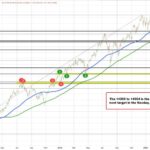
US-Europe Tariff Talks Heat Up: Paving the Way for Zero Tariffs and Free Trade
Tháng 4 7, 2025
Navigating Turbulence: S&P 500 & Nasdaq Outlook Amid Market Uncertainty
Tháng 4 7, 2025Strong Employment Trends in the U.S.: An Analysis of March 2025 Job Growth
The U.S. job market showcased impressive resilience in March 2025, underscoring a robust economic landscape that defied initial expectations. Recent data reveals that nonfarm payroll employment surged by 228,000, substantially outperforming the predicted growth of around 140,000 jobs. This robust increase not only highlights a thriving employment sector but also surpasses the average monthly gain of 158,000 jobs recorded over the past year. This optimistic trend comes amid various economic challenges, including fluctuating interest rates and evolving policy frameworks.
Key Industries Driving Job Creation
March’s employment surge was primarily fueled by significant growth in several key industries, showcasing diverse job creation that points toward an adaptable economy.
Health Care remained at the forefront, adding an impressive 54,000 jobs. This ongoing trend reflects the increasing demand for health-related services, a sector that consistently proves to be resilient against economic fluctuations. The need for skilled healthcare professionals continues to rise, indicative of a broader societal shift toward prioritizing health and wellness.
For investors looking to understand critical sectors, insights can be drawn from valuable investment strategies like those discussed in this analysis of value investing.
Social Assistance also saw notable growth, with 24,000 new jobs created in this sector. This increase underscores the growing demand for support services, particularly as communities grapple with various socio-economic challenges.
Transportation and Warehousing reported a gain of 23,000 jobs, propelled by a notable spike in courier and messenger services (+16,000) and truck transportation (+10,000). This trend exemplifies the continuing importance of e-commerce and logistics in the modern economy. However, it is worth mentioning that warehousing and storage experienced a drop, losing 9,000 jobs, signaling potential shifts in logistics strategies or market demands.
In the Retail Trade sector, 24,000 jobs were added, a growth partly attributed to individuals returning to work after labor strikes. This situation highlights the complex interplay between labor relations and employment figures, emphasizing that industry advancements can be influenced by various external factors, including workforce negotiations.
Stability Amidst Economic Challenges
The unemployment rate held steady at 4.2%, which, despite being slightly above expectations, reflects an overall stability in the labor market. This figure indicates that while job creation is robust, some challenges remain that could hinder broader economic recovery.
On the flip side, federal government employment experienced a decline of 4,000 jobs, continuing a trend of reductions in government roles. This drop may reflect fiscal tightening measures or shifts in governmental priorities, which could have implications for public service delivery and employment.
Looking Ahead
As we analyze these encouraging employment trends, it’s crucial to consider the potential economic headwinds that could impact future job growth. Factors such as rising interest rates and potential shifts in policy at both the federal and state levels may create challenges for hiring in the coming months. For example, understanding the pitfalls investors face might help manage risks in such an uncertain environment, as outlined in key investment mistakes to avoid. Nevertheless, the job market’s performance in March 2025 serves as a testament to the adaptability and resilience of the U.S. economy, positioning it favorably for future growth.
As we delve deeper into 2025, monitoring these employment trends will be essential for understanding the intricate dynamics of the job market and making informed decisions, both politically and economically. The continued importance of strategic investment decisions cannot be overlooked, and avoiding common investment missteps is crucial for achieving success in this evolving landscape, as detailed in Barry Ritholtz’s investment insights.

